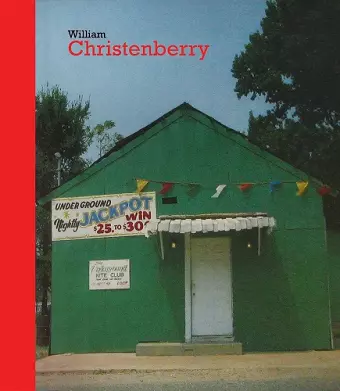William Christenberry
Justo Navarro author Yolanda Romero author François Cadava author Carlos Martin author
Format:Hardback
Publisher:Distributed Art Publishers
Published:16th Jan '14
Currently unavailable, our supplier has not provided us a restock date

"Modesty and discretion characterize everything Christenberry touches.” –Richard B. Woodward, The New York Times William Christenberry is firmly established as a contemporary American master photographer, but no comprehensive overview of his diverse talents is currently in print. This 260-page volume--the largest Christenberry overview yet published--corrects this lacuna, offering a thematic survey of his half-century-long career. It is composed of 13 sections, each devoted to a particular series or theme: the wooden sculptures of Southern houses, cafes and shops; the early, black-and-white, Walker Evans-influenced photographs of Southern interiors, taken in Alabama and Mississippi in the early 60s; documentations of Ku Klux Klan meeting houses and rallies, from the mid-1960s; color photographs of tenant houses in Alabama, from 1961 to 1978; signs in landscapes, ranging from handwritten gas station signs to Klan and corporate signs; graves (which, through Christenberry's lens, emerge as a kind of folk art); churches in Alabama, Delaware and Mississippi, taken between the mid-1960s and the 80s; Alabama street scenes, in towns such as Demopolis, Marion and Greensboro; street scenes in Tennessee (mostly Memphis); Southern landscapes; gas stations, trucks and cars in Alabama; and a selection from Christenberry's famous series of buildings to which he returns annually, photographing them over several decades-the palmist building, the Underground Nite Club, Coleman's Cafe, the Bar-B-Q Inn, the Green Warehouse and the Christenberry family home, near Stewart, Alabama. William Christenberry (born 1936) has been a professor at the Corcoran College of Art and Design, Washington, D.C., since 1968. His work has been the subject of numerous solo exhibitions over the last 40 years, and can be found in numerous permanent collections, including those of the Smithsonian American Art Museum, Washington, D.C.; The Museum of Modern Art and Whitney Museum of American Art, New York; San Francisco Museum of Modern Art; and the Center for Creative Photography, Tucson. His work was the subject of a major year-long solo exhibition at the Smithsonian American Art Museum in 2006.
Following in the footsteps and traditions of Walker Evans, James Agee, and William Faulkner, since the 1960s Christenberry (b. 1936) has vividly documented the disappearing rural landscape of the American South, particularly scenes from his youth in Hale County, AL. This evocative catalogue to a Spanish exhibition of 300 photographs and a dozen sculptures aims to widen his exposure in Europe. Christenberry's quietly evocative images capture and recapture (he often photographs the same buildings and locales year after year) the decline, deterioration, and transformation of abandoned tenant-farmer houses and other buildings, country churches and cemeteries, and dilapidated advertising signs. Included in the show is The Klan Room (1962-97), an installation of signage, photos, and artifacts that have haunted him since he briefly attended a Ku Klux Klan meeting in 1960. Atypical urban landscapes of Beale Street, Memphis, round out the exhibition. Essays introduce and comment on his life, motifs, and documentary style. Other noteworthy, recent additions to the photographer's critical canon include William Christenberry, by A. Grundberg et al., written to accompany the Smithsonian exhibition Passing Time (2006); and the monographs William Christenberry: Working from Memory: Collected Stories, compiled and edited by S. Lange (2008), and Christenberry's Kodachromes (2010). Summing Up: Recommended. Lower-level undergraduates and above; general readers. -- R.T. Clement * CHOICE *
Alabama pulses deep within the artistic DNA of the photographer William Christenberry, born in Tuscaloosa in 1936. And these photographs, most taken in Alabama in the 1960s and '70s, tell takes of an older, vanished South from inside that South. -- Dana Jennings * The New York Times *
The 260-page volume is divided into 13 sections - each dedicated to a recurring theme in Christenberry's works - and covers the range of his career, from early black-and-white photos of interiors clearly influenced by Christenberry's original hero, Evans, to the buildings he returns to annually, including the Bar-B-Q Inn and his grandparents' home in Alabama. -- Molly Young * WSJ Magazine *
ISBN: 9781938922275
Dimensions: unknown
Weight: unknown
260 pages